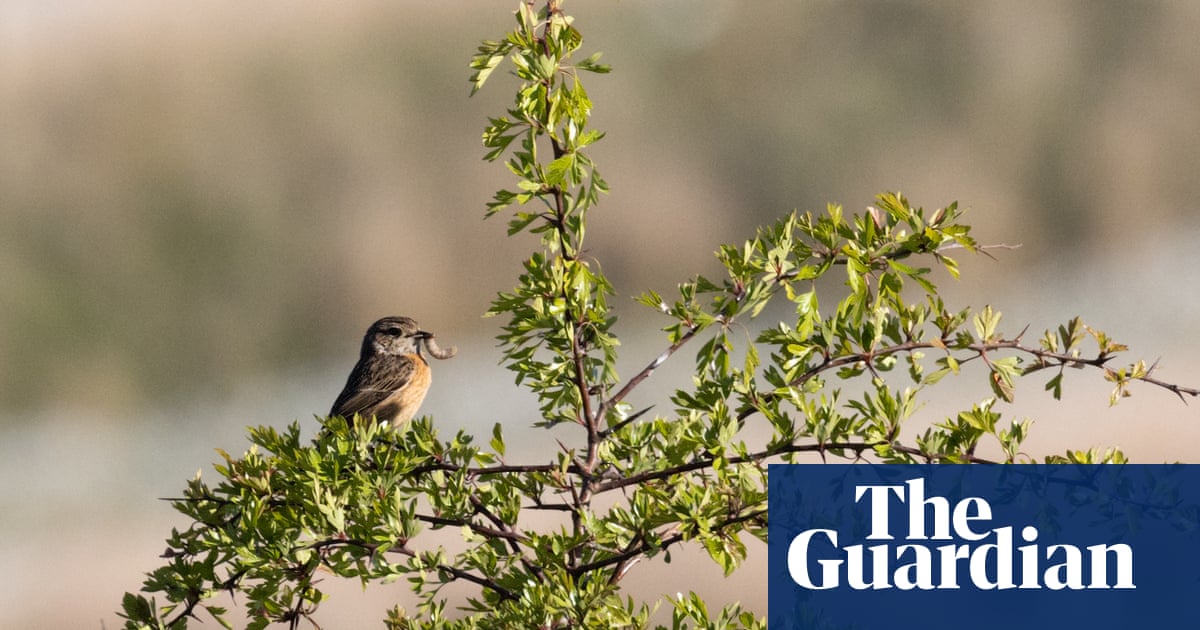The Howgill Fells are a smooth, treeless cluster of hills in theYorkshireDales national park, so bald and lumpy that they are sometimes described as a herd of sleeping elephants. Their bare appearance – stark even by UK standards – has been shaped by centuries of sheep grazing. Yet beneath the soil lie ancient tree roots: the silent traces of long-lost “ghost woodlands”.
Now, these woodlands are being encouraged to grow again. Over the past 12 years, 300,000 native trees have been planted across these hills in sheep-free enclosures. The results are beginning to be seen: birds and flowers are returning.
Birdsong ripples through the valley as first light spills over a ridge line and on to 26 hectares (64 acres) of fenced-off land near Tebay village. Meadow pipits, reed buntings and stonechats are among the choristers. A flush of cotton grass bobs in the morning breeze and a stonechat fledgling clings to a spindly branch, shrieking for a parent.
“We’ve been conditioned to see the uplands as barren for much of the year. It needn’t be that way,” says ecologist Mike Douglas from South Lakes Ecology, who is monitoring birds in the enclosures. “We are 10 years into what was ecologically very damaged land,” says Douglas, who is conducting his first of four surveys for the 2025 season.
Big rewilding projects often happen on private land with limited public access. These enclosures are a result of agreements reached between dozens of farmers on common land with public access. “Doing so much tree-planting on a common was groundbreaking,” says Peter Leeson from the Woodland Trust. “People hadn’t been doing this in the uplands before at this scale.”
Bluebells are popping up and there are patches of bracken, which suggest the soils and seed banks retain the memory of being a woodland despite hundreds of years of sheep grazing. “We call these memories ‘ghost woodlands’,” says Leeson. These ancient woodland indicators could offer a blueprint of where trees should return.
Each year, Douglas is finding more breeding birds moving in. Last year, there were 14 breeding species here. Before the enclosure was created, he says, just four would have been found: meadow pipit, skylarks, wren and grey wagtails. Eleven new breeding bird species have been recorded since the original 2016 survey, with numbers increasing year-on-year. “I’m surprised by how quickly birds have colonised, and the diversity of species,” says Douglas.
Tree planting covers 12% of the entire 128-hectare (316-acre) fell. The enclosures were possible thanks to a 10-year government agri-environment scheme, signed by farmers with grazing rights to the fell as part of the Tebay Common Grazing Association, and the owner of the fell, Lonsdale Estates, supported and monitored by the Woodland Trust.
Leeson says schemes like this could be echoed in other upland areas, which covermore than a thirdof the UK and aregenerally grazedor managed so woodlands are suppressed. “This is a wonderful exemplar of what could happen – if we choose to,” he says.
Across Europe, conflicts between farmers and conservationistsare increasingdue to the need for maintaining food production while creating space for nature. This conflict tends to be especially pronounced in the uplands because the land is relatively unproductive for farming. “Farmer and conservation collaboration is the real joy,” Leeson says. “We want the same things. We want to be listened to, and heard and involved. I’d say we’re friends now.”
John Capstick, chair of the Ravenstonedale Common Graziers Association, which hosts 187 hectares (462 acres) of fenced off land, says at first some farmers “were dead against it being fenced off. They were frightened it was an ulterior motive to get sheep off the fell.” Now, “there is the odd one who still whines,” but most are happy, he says.
In fact, the trees are not proving a threat to hill farming. The money is a lifeline for farmers, whoearn as little as £7,500a year from selling sheep and have been reliant ondisappearing government subsidies. The Tebay scheme provides payments of £25,600 a year for maintaining the trees and fences and for loss of grazing rights, which are shared equally between the landowner and the farmers.
Twenty-five years ago, there were 25 farmers on Tebay common. Now there are 10. For those who still graze on the common, the payments are “keeping them going”, says Tim Winder, chair of the Tebay Common Grazing Association, whose father’s family have been farming for as long as they can remember.
Now, Winder is working with researchers on using the fells for peatland restoration andnatural flood management. “We have to look at different ways of farming,” he says. “We’ll invite anyone to work with us.”
In the years to come, patches of mature woodland and scrubland will develop here, and common birds such as great tits, blue tits, dunnocks and blackbirds, will move in, says Douglas. It is a mystery what these hills may have looked like hundreds of years ago – no detailed historical records exist. Ghost woodlands speak of not only what has been lost, but what could one day return. “This was a leap in the dark for the farmers, as much as anyone else,” says Leeson. “Hats off to them.”
Find moreage of extinction coverage here, and follow the biodiversity reportersPhoebe WestonandPatrick Greenfieldin the Guardian app for more nature coverage
